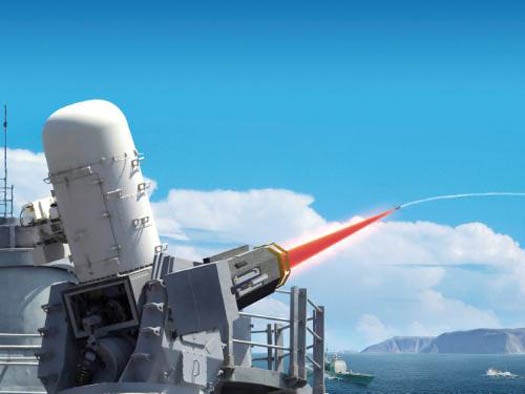Video: Raytheon’s Ship-Mounted Laser Weapon Incinerates a UAV in Flight
Raytheon revealed its next-gen directed energy weapon at the Farnborough Air Show today, releasing video showing its Laser Weapons System...

Raytheon revealed its next-gen directed energy weapon at the Farnborough Air Show today, releasing video showing its Laser Weapons System (LaWS) — a six-laser weapon that focuses on a single target — engaging and then destroying an unmanned aerial vehicle from the deck of a Navy vessel at sea.
The tests, conducted in May and June, show the LaWS illuminating and then heating the underside of a drone aircraft shortly before it goes up in flames and loses trajectory, plummeting into the ocean below. Guided by Raytheon’s Laser Close-in Weapon System (CIWS), a sensor suite that locks onto and guides the energy weapon, LaWS shot down three similar drones during the tests, which mark the first time a solid-state laser has shot down an aircraft on the wing over open seas.
There are three significant parts to this story. First, it’s important to note that LaWS is a solid-state laser rather than a chemical laser, which means it’s not quite so hazardous to handle and requires less energy to use. It’s also smaller, which makes it a lot more feasible to pack onto a naval vessel. Second, solid-state lasers are generally weaker than chemical lasers, and that problem is compounded by the moist air in ocean climates, as that moisture can absorb laser energy and weaken the beam. So proving this solid-state technology can work at sufficient strengths over the ocean is a serious milestone.
But most importantly, Raytheon demonstrated that a laser integrated into the Navy’s Phalanx anti-missile defense system — a weapons system already mounted on many naval vessels — can hit a moving target from the deck of a ship, which itself is moving and rolling along with the ocean. That’s pretty sharp shooting, and it could arm U.S. seamen with a greatly enhanced last line of defense during aerial and ballistic missile warfare at sea.
Of course, what works on a moving naval platform also works from stationary, land-based positions, and Raytheon is also looking to mount the system on trailers much as Boeing has done with its Mobile Active Targeting Resource for Integrated experiments (MATRIX). That system, along with some of Boeing’s other directed energy systems, shot down several UAVs last year. But if Raytheon can do it in a smaller, less energy-intensive package the military might find that more compact solid-state lasers are the future.
Check out the CIWS roasting a drone below.